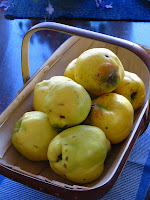Ali's notes on each year's batch surround her copy of Lois Daish's jelly recipe from the Listener. "The amount of jelly you get from a kilo of quinces seems to vary – I find that early in the season they produce more liquid (and the jelly sets faster) than later in the season when the fruit is riper. I usually buy about 3 kg of quinces as soon as they appear, around the beginning of April. This makes about 15 small to medium jars of jelly, enough to share with family and friends. You can of course make much smaller batches."
 Ali's Quince Jelly
Ali's Quince Jelly (adapted, with gratitude, from Lois Daish, 13 April 2002)
Quinces, water, sugar (you’ll need about 1 kg of sugar per 1 kg of fruit – but see exact formula below)
Wash quinces and chop them into small pieces, skin, cores and all. Put into a preserving pan or large heavy pot, and barely cover with cold water. Bring to boil and simmer (uncovered) until fruit is very soft and pinkish in colour – about 1 hour.
Allow to cool slightly, then transfer fruit and liquid into a jelly bag placed in a large bowl. (You can make a jelly bag yourself, out of muslin or cotton, or use an old cotton pillow case or even an old tea towel, with diagonal corners tied together.) Make sure the bowl is big enough – 3 kg of quinces should produce between 2.5 and 3 litres of liquid. Tie the neck of the bag securely with string, and suspend it over the bowl to drip for several hours or overnight. (I tie the top of the bag around an old broom handle, which I place across the bath with the bowl underneath.) Don’t squeeze the bag – it will make the jelly cloudy.
Meanwhile, wash enough jars and lids (I always prepare a few more than I think I’ll need). Just before you start the next step, put the clean jars in the oven and set the temperature to 100 degrees Celsius. Leave them at that heat to sterilise until the jelly is ready. Boil the metal lids for 5 minutes, then drain and leave in the saucepan to dry.
Pour the lovely pink liquid from the bowl into a measuring jug, note the quantity, then pour it into the clean pot. Bring to the boil and add 1 kg of sugar for every litre of liquid. Bring slowly back to the boil, stirring until sugar has dissolved. (At this stage, put a saucer in the freezer, for testing the jelly later.) Turn up the heat and boil briskly. A white scum will form around the edges. Skim it off occasionally with a slotted metal spoon. (Put the scum in a small bowl – it will set, and is delicious.)
Start testing to see if liquid has reached setting point after about 10 minutes (or 5 minutes for a small quantity), then at 5 minute intervals after that. There are two ways of testing (I use both):
(1) Place a spoonful of liquid on the cold saucer, let it cool a little, then run your finger through the middle – if the two sides stay separate (i.e. the liquid doesn’t run together again), the jelly is almost ready.
(2) Scoop up some of the hot liquid with the slotted metal spoon and let it drip back into the pot. If the last few drops thicken, drop more slowly, and start to clump together, the jelly is ready.
(When I make my usual large batch early in the season, the jelly is ready after about 20-30 minutes of steady boiling. But I always start testing earlier, just in case – if boiled for too long, the jelly will be rubbery.)
When the jelly is ready, turn off the heat at once. Pour the hot liquid into the hot jars, using a stainless steel or pyrex jug. Fill jars nearly to the brim, and seal with the sterilised lids. When cool, label the jars and store in a cool place. Once you open a jar, keep it in the fridge.
* The drained fruit pulp needn’t go to waste – I usually empty the jelly bag onto the compost heap, but one year, after getting a disappointingly small batch of jelly later in the season, I used the pulp to make a batch of quince paste!





2 comments:
I was overly ambitious last week and now am up to my ears in quince paste... but I may have to give this jelly a spin, too. Love that colour!
Yes, it's beautiful, Anne - I can't imagine how you manage all these projects, but the blog is great!
Post a Comment